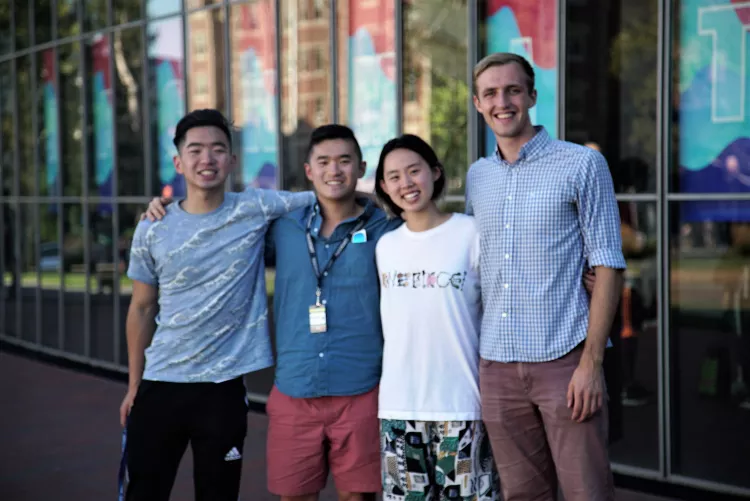Swarthmore Team Wins Two Awards at MIT Hackathon

Jason Jin ’20, Henry Han ’20, Theint Kyaw ’19, and Kastan Day ’20 placed in the top 10 at HackMIT for their self-writing journal that generates a daily summary of people’s lives by drawing on features from their mobile devices.
For the second year in a row, a computer science-based project from a team of Swarthmore students earned a top-10 finish at the annual HackMIT tournament.
The student-run hackathon, held last month at the Massachusetts Institute of Technology, challenged teams to design their own working prototypes of innovative web and mobile applications using machine learning and computer programming.
Kastan Day ’20, a computer science major from Seattle; Henry Han ’20, a cognitive science and computer science special major from Bellingham, Wash.; Jason Jin ’20, a cognitive science and computer science special major from Union City, Calif.; and Theint Kyaw ’19, an art and computer science major from Yangon, Myanmar, created and presented their independently designed application, Lotus Journal. The self-writing journal generates a daily summary of people’s lives by drawing on mobile device features that people already use daily, including photos, videos, location services, and Fitbit.
The team took home two major prizes for their use of machine learning: Most Interesting Use of Text-Based Machine Learning, presented by Quora, and Microsoft’s Azure Champ award, which automatically qualified the group to participate in the Imagine Cup, a global computer science competition.
Lotus Journal was an ambitious undertaking, since coding for a diary that generates text by interacting with other applications is a new area of computer science research. In order to create the application, the team had to experiment with machine learning techniques.
“To win a hackathon, prep is crucial,” Day said of the motivation behind taking on a challenging project. “You need to come in with a strong idea, ready to hit the ground running, and implementing like crazy.”
Day added that “cleverness, aka ‘hacky-ness,’” is what led to back-to-back years of success for Swarthmore teams. A group featuring Day, Han, Jin, and Joshua Freier ’20 was honored in 2017 for a novel implementation of machine learning for fake news detection.
Getting into HackMIT is an accomplishment in itself: To qualify for the hackathon, the team had to solve a challenging seven-part admissions coding puzzle. At the tournament, which featured more than 400 teams and 1,200 hackers, the students had 24 hours to code and implement their application.
Although they were excited to contribute to a new field of research through experimenting with machine learning, the students’ decision to design Lotus Journal related to social impact. For them, creating a journal application that allows for self-reflection is a way to help people achieve personal wellness.
“Journaling can have so many benefits, such as enhancing creativity, reducing stress, and helping you process and heal your thoughts and feelings,” says Jin.
Beyond the project, the students said HackMIT 2018 was a valuable experience as it provided them with opportunities to learn from professionals in the field. The event featured guest speakers from technology startups and well-known web companies, some of whom also participated in a “fireside chat” where students could casually ask them questions.
As the students improve upon their HackMIT project in preparation for Imagine Cup, they look forward to further investigating how the app benefits its users.
“There are also so many insights to be found in things like your mood and activity, such as identifying good versus bad habits and even correlations between mood and activity,” says Jin. “Those insights are what we would like to explore down the road.”
Since returning to campus, the team has been working with Katie Clark, director of the Center for Innovation and Leadership, to implement design-thinking methodologies into their process—conducting empathy interviews to further define the needs and perspectives of their potential users, and using that information to better inform project development.
“I have been working with this group of students since they participated in SwatTank in spring 2018,” says Clark. “They are a highly motivated and talented group of students who have shown time and time again that your team dynamics, communication skills while working on a project, and care for the user experience can be just as important as the technical aspects of the work.”



